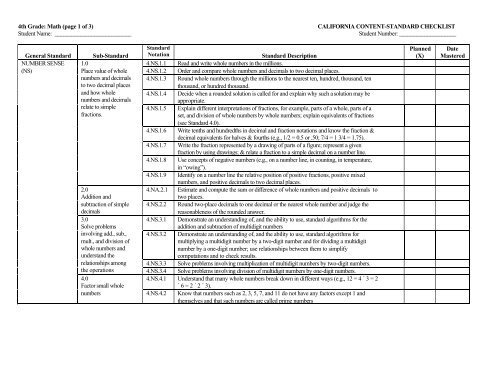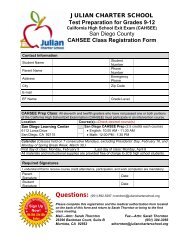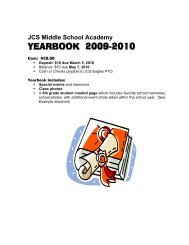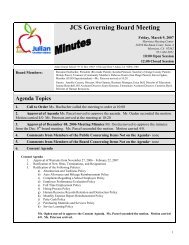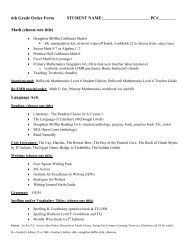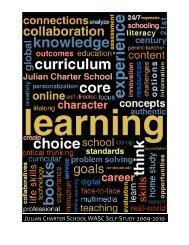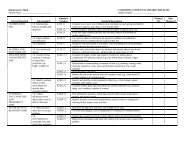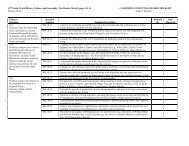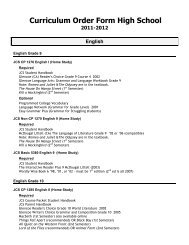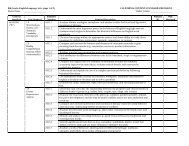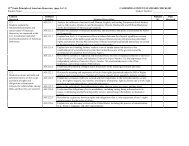4th Grade: Math (page 1 of 3) CALIFORNIA CONTENT-STANDARD ...
4th Grade: Math (page 1 of 3) CALIFORNIA CONTENT-STANDARD ...
4th Grade: Math (page 1 of 3) CALIFORNIA CONTENT-STANDARD ...
You also want an ePaper? Increase the reach of your titles
YUMPU automatically turns print PDFs into web optimized ePapers that Google loves.
<strong>4th</strong> <strong>Grade</strong>: <strong>Math</strong> (<strong>page</strong> 1 <strong>of</strong> 3)<br />
Student Name: ___________________________<br />
<strong>CALIFORNIA</strong> <strong>CONTENT</strong>-<strong>STANDARD</strong> CHECKLIST<br />
Student Number: ____________________<br />
General Standard<br />
NUMBER SENSE<br />
(NS)<br />
Sub-Standard<br />
Standard<br />
Notation<br />
Standard Description<br />
1.0<br />
4.NS.1.1 Read and write whole numbers in the millions.<br />
Place value <strong>of</strong> whole 4.NS.1.2 Order and compare whole numbers and decimals to two decimal places.<br />
numbers and decimals 4.NS.1.3 Round whole numbers through the millions to the nearest ten, hundred, thousand, ten<br />
to two decimal places<br />
thousand, or hundred thousand.<br />
and how whole<br />
4.NS.1.4 Decide when a rounded solution is called for and explain why such a solution may be<br />
numbers and decimals<br />
appropriate.<br />
relate to simple 4.NS.1.5 Explain different interpretations <strong>of</strong> fractions, for example, parts <strong>of</strong> a whole, parts <strong>of</strong> a<br />
fractions.<br />
set, and division <strong>of</strong> whole numbers by whole numbers; explain equivalents <strong>of</strong> fractions<br />
(see Standard 4.0).<br />
4.NS.1.6 Write tenths and hundredths in decimal and fraction notations and know the fraction &<br />
decimal equivalents for halves & fourths (e.g., 1/2 = 0.5 or .50; 7/4 = 1 3/4 = 1.75).<br />
4.NS.1.7 Write the fraction represented by a drawing <strong>of</strong> parts <strong>of</strong> a figure; represent a given<br />
fraction by using drawings; & relate a fraction to a simple decimal on a number line.<br />
4.NS.1.8 Use concepts <strong>of</strong> negative numbers (e.g., on a number line, in counting, in temperature,<br />
in “owing”).<br />
4.NS.1.9 Identify on a number line the relative position <strong>of</strong> positive fractions, positive mixed<br />
numbers, and positive decimals to two decimal places.<br />
2.0<br />
4.NA.2.1 Estimate and compute the sum or difference <strong>of</strong> whole numbers and positive decimals to<br />
Addition and<br />
two places.<br />
subtraction <strong>of</strong> simple 4.NS.2.2 Round two-place decimals to one decimal or the nearest whole number and judge the<br />
decimals<br />
reasonableness <strong>of</strong> the rounded answer.<br />
3.0<br />
4.NS.3.1 Demonstrate an understanding <strong>of</strong>, and the ability to use, standard algorithms for the<br />
Solve problems<br />
addition and subtraction <strong>of</strong> multidigit numbers<br />
involving add., sub., 4.NS.3.2 Demonstrate an understanding <strong>of</strong>, and the ability to use, standard algorithms for<br />
mult., and division <strong>of</strong><br />
multiplying a multidigit number by a two-digit number and for dividing a multidigit<br />
whole numbers and<br />
number by a one-digit number; use relationships between them to simplify<br />
understand the<br />
computations and to check results.<br />
relationships among 4.NS.3.3 Solve problems involving multiplication <strong>of</strong> multidigit numbers by two-digit numbers.<br />
the operations 4.NS.3.4 Solve problems involving division <strong>of</strong> multidigit numbers by one-digit numbers.<br />
4.0<br />
4.NS.4.1 Understand that many whole numbers break down in different ways (e.g., 12 = 4 ´ 3 = 2<br />
Factor small whole<br />
´ 6 = 2 ´ 2 ´ 3).<br />
numbers 4.NS.4.2 Know that numbers such as 2, 3, 5, 7, and 11 do not have any factors except 1 and<br />
themselves and that such numbers are called prime numbers<br />
Planned<br />
(X)<br />
Date<br />
Mastered
<strong>4th</strong> <strong>Grade</strong>: <strong>Math</strong> (<strong>page</strong> 2 <strong>of</strong> 3)<br />
Student Name: ___________________________<br />
CALFORNIA <strong>CONTENT</strong>-<strong>STANDARD</strong> CHECKLIST<br />
Student Number: ____________________<br />
General Standard<br />
ALGEBRA AND<br />
FUNCTIONS (AF)<br />
MEASUREMENT<br />
AND GEOMETRY<br />
(MG)<br />
Sub-Standard<br />
Standard<br />
Notation<br />
Standard Description<br />
1.0<br />
4.AF.1.1 Use letters, boxes, or other symbols to stand for any number in simple expressions or<br />
Use and interpret<br />
equations (e.g., demonstrate an understanding and the use <strong>of</strong> the concept <strong>of</strong> a variable).<br />
variables,<br />
4.AF.1.2 Interpret and evaluate mathematical expressions that now use parentheses.<br />
mathematical symbols, 4.AF.1.3 Use parentheses to indicate which operation to perform first when writing expressions<br />
and properties to<br />
Containing more than two terms and different operations.<br />
write and simplify 4.AF.1.4 Use and interpret formulas (e.g., area = length ´ width or A = lw) to answer questions<br />
expressions and<br />
about quantities and their relationships.<br />
sentences 4.AF.1.5 Understand that an equation such as y = 3x + 5 is a prescription for determining a<br />
second number when a first number is given.<br />
2.0<br />
4.AF.2.1 Know and understand that equals added to equals are equal.<br />
Manipulate equations 4.AF.2.2 Know and understand that equals multiplied by equals are equal<br />
1.0<br />
4.MG.1.1 Measure the area <strong>of</strong> rectangular shapes by using appropriate units, such as square<br />
Perimeter and Area<br />
centimeter (cm 2 ), square meter (m 2 ), square kilometer (km 2 ), square inch (in 2 ),<br />
square yard (yd 2 ), or square mile (mi 2 ).<br />
4.MG.1.2 Recognize that rectangles that have the same area can have different perimeters.<br />
2.0<br />
Use two-dimensional<br />
coordinate grids to<br />
represent points and<br />
graph lines and simple<br />
figure<br />
3.0<br />
Plane and solid<br />
geometric objects<br />
4.MG.1.3<br />
4.MG.1.4<br />
Understand that rectangles that have the same perimeter can have different areas.<br />
Understand and use formulas to solve problems involving perimeters and areas <strong>of</strong><br />
rectangles and squares. Use those formulas to find the areas <strong>of</strong> more complex figures by<br />
dividing the figures into basic shapes.<br />
4.MG.2.1 Draw the points corresponding to linear relationships on graph paper (e.g., draw 10<br />
points on the graph <strong>of</strong> the equation y = 3x and connect them by using a straight line).<br />
4.MG.2.2 Understand that the length <strong>of</strong> a horizontal line segment equals the difference <strong>of</strong> the x-<br />
coordinates.<br />
4.MG.2.3 Understand that the length <strong>of</strong> a vertical line segment equals the difference <strong>of</strong> the y-<br />
coordinates.<br />
4.MG.3.1 Identify lines that are parallel and perpendicular<br />
4.MG.3.2 Identify the radius and diameter <strong>of</strong> a circle.<br />
4.MG.3.3 Identify congruent figures.<br />
4.MG.3.4 Identify figures that have bilateral and rotational symmetry.<br />
4.MG.3.5 Know the definitions <strong>of</strong> a right angle, an acute angle, and an obtuse angle. Understand<br />
that 90°, 180°, 270°, and 360° are associated, respectively, with 1 Ú4, 1 Ú2, 3 Ú4, and<br />
full turns.<br />
4.MG.3.6<br />
4.MG.3.7<br />
4.MG.3.8<br />
Visualize, describe, and make models <strong>of</strong> geometric solids (e.g., prisms, pyramids) in<br />
terms <strong>of</strong> the number and shape <strong>of</strong> faces, edges, and vertices; interpret two-dimentional<br />
representations <strong>of</strong> three-dimensional objects; and draw patterns (<strong>of</strong> faces) for a solid<br />
that, when cut and folded, will make a model <strong>of</strong> the solid.<br />
Know the definitions <strong>of</strong> different triangles (e.g., equilateral, isosceles, scalene) and<br />
identify their attributes.<br />
Know the definition <strong>of</strong> different quadrilaterals (e.g., rhombus, square, rectangle,<br />
parallelogram, trapezoid).<br />
Planned<br />
(X)<br />
Date<br />
Mastered
<strong>4th</strong> <strong>Grade</strong>: <strong>Math</strong> (<strong>page</strong> 3 <strong>of</strong> 3)<br />
Student Name: ___________________________<br />
<strong>CALIFORNIA</strong> <strong>CONTENT</strong>-<strong>STANDARD</strong> CHECKLIST<br />
Student Number: ____________________<br />
General Standard<br />
STATISTICS,<br />
DATA ANALYSIS,<br />
& PROBABILITY<br />
(SDP)<br />
MATHEMATICAL<br />
REASONING (MR)<br />
Sub-Standard<br />
Standard<br />
Notation<br />
Standard Description<br />
1.0<br />
4.SDP.1.1 Formulate survey questions; systematically collect and represent data on a number line;<br />
Organize, represent,<br />
and coordinate graphs, tables, and charts.<br />
& interpret numerical 4.SDP.1.2 Identify the mode(s) for sets <strong>of</strong> categorical data and the mode(s), median, and any<br />
& categorical data &<br />
apparent outliers for numerical data sets.<br />
clearly communicate 4.SDP.1.3 Interpret one- and two-variable data graphs to answer questions about a situation.<br />
their findings<br />
2.0<br />
4.SDP.2.1 Represent all possible outcomes for a simple probability situation in an organized way<br />
Make predictions for<br />
(e.g., tables, grids, tree diagrams).<br />
simple probability 4.SDP.2.2 Express outcomes <strong>of</strong> experimental probability situations verbally and numerically (e.g.,<br />
situations<br />
3 out <strong>of</strong> 4; 3 Ú4<br />
1.0<br />
4.MR.1.1 Analyze problems by identifying relationships, distinguishing relevant from irrelevant<br />
Approaching<br />
information, sequencing and prioritizing information, and observing patterns.<br />
problems 4.MR.1.2 Determine when and how to break a problem into simpler parts.<br />
2.0<br />
4.MR.2.1 Use estimation to verify the reasonableness <strong>of</strong> calculated results.<br />
Strategies, skills, and 4.MR.2.2 Apply strategies and results from simpler problems to more complex problems.<br />
concepts in finding 4.MR.2.3 Use a variety <strong>of</strong> methods, such as words, numbers, symbols, charts, graphs, tables,<br />
solutions<br />
diagrams, and models, to explain mathematical reasoning.<br />
4.MR.2.4 Express the solution clearly and logically by using the appropriate mathematical<br />
notation and terms and clear language; support solutions with evidence in both verbal<br />
and symbolic work.<br />
4.MR.2.5 Indicate the relative advantages <strong>of</strong> exact and approximate solutions to problems and<br />
give answers to a specified degree <strong>of</strong> accuracy.<br />
4.MR.2.6 Make precise calculations and check the validity <strong>of</strong> the results from the context <strong>of</strong> the<br />
problem.<br />
3.0<br />
4.MR.3.1 Evaluate the reasonableness <strong>of</strong> the solution in the context <strong>of</strong> the original situation.<br />
Moving beyond a 4.MR.3.2 Note the method <strong>of</strong> deriving the solution and demonstrate a conceptual understanding<br />
problem<br />
<strong>of</strong> the derivation by solving similar problems.<br />
4.MR.3.3 Develop generalizations <strong>of</strong> the results obtained and apply them in other circumstances.<br />
Planned<br />
(X)<br />
Date<br />
Mastered
<strong>4th</strong> <strong>Grade</strong>: English-Language Arts (<strong>page</strong> 1 <strong>of</strong> 3)<br />
<strong>CALIFORNIA</strong> <strong>CONTENT</strong>-<strong>STANDARD</strong> CHECKLIST<br />
Student Name: ____________________ Student Number: __________________<br />
General<br />
Standard<br />
READING<br />
(“R”)<br />
Sub-Standard<br />
1.0<br />
Word Analysis,<br />
Fluency, and<br />
Systematic<br />
Vocabulary<br />
Development<br />
2.0<br />
Reading<br />
Comprehension<br />
(read ½ million<br />
words annually)<br />
3.0<br />
Literary<br />
Response and<br />
Analysis<br />
WRITING (W) 1.0<br />
Writing<br />
Strategies<br />
Standard<br />
Notation<br />
4.R.1.1<br />
4.R.1.2<br />
4.R.1.3<br />
4.R.1.4<br />
4.R.1.5<br />
4.R.1.6<br />
4.R.2.1<br />
4.R.2.2<br />
4.R.2.3<br />
4.R.2.4<br />
4.R.2.5<br />
4.R.2.6<br />
4.R.2.7<br />
4.R.3.1<br />
4.R.3.2<br />
4.R.3.3<br />
4.R.3.4<br />
4.R.3.5<br />
4.W.1.1<br />
4.W.1.2.a<br />
4.W.1.2.b<br />
4.W.1.2.c<br />
4.W.1.2.d<br />
4.W.1.2.e<br />
4.W.1.3<br />
Standard Description<br />
Read narrative and expository text aloud with grade-appropriate fluency and accuracy and with<br />
appropriate pacing, intonation, and expression.<br />
Apply knowledge <strong>of</strong> word origins, derivations, synonyms, antonyms, and idioms to determine<br />
the meaning <strong>of</strong> words and phrases.<br />
Use knowledge <strong>of</strong> root words to determine the meaning <strong>of</strong> unknown words within a passage.<br />
Know common roots and affixes derived from Greek and Latin and use this knowledge to<br />
analyze the meaning <strong>of</strong> complex words (e.g., international).<br />
Use a thesaurus to determine related words and concepts<br />
Distinguish and interpret words with multiple meanings<br />
Identify structural patterns found in informational text (e.g., compare and contrast, cause and<br />
effect, sequential or chronological order, proposition & support) to strengthen comprehension.<br />
Use appropriate strategies when reading for different purposes (e.g., full comprehension,<br />
location <strong>of</strong> information, personal enjoyment).<br />
Make and confirm predictions about text by using prior knowledge & ideas presented in the<br />
text, including illustrations, titles, topic sentences, important words, & foreshadowing clues<br />
Evaluate new information and hypotheses by testing them against known information & ideas.<br />
Compare and contrast information on the same topic after reading several passages or articles.<br />
Distinguish between cause and effect and between fact and opinion in expository text<br />
Follow multiple-step instructions in a basic technical manual (e.g., how to use computer<br />
commands or video games).<br />
Describe the structural differences <strong>of</strong> various imaginative forms <strong>of</strong> literature, including<br />
fantasies, fables, myths, legends, and fairy tales<br />
ID the main events <strong>of</strong> the plot, their causes, & the influence <strong>of</strong> each event on future actions.<br />
Use knowledge <strong>of</strong> the situation and setting and <strong>of</strong> a character’s traits and motivations to<br />
determine the causes for that character’s actions.<br />
Compare and contrast tales from different cultures by tracing the exploits <strong>of</strong> one character type<br />
and develop theories to account for similar tales in diverse cultures (e.g., trickster tales)<br />
Define figurative language (e.g., simile, metaphor, hyperbole, personification) & ID its use in<br />
literary works.<br />
Select a focus, an organizational structure, and a point <strong>of</strong> view based upon purpose, audience,<br />
length, and format requirements.<br />
Create multiple-paragraph compositions: Provide an introductory paragraph<br />
Create multiple-paragraph compositions: Establish and support a central idea with a topic<br />
sentence at or near the beginning <strong>of</strong> the first paragraph.<br />
Create multiple-paragraph compositions: Include supporting paragraphs with simple facts,<br />
details, and explanations<br />
Create multiple-paragraph compositions: Conclude w/ a paragraph that summarizes the points<br />
Create multiple-paragraph compositions: Use correct indention<br />
Use traditional structures for conveying information (e.g., chronological order, cause and<br />
Effect, similarity and difference, and posing and answering a question).<br />
Planned<br />
(X)<br />
Date<br />
Mastered
<strong>4th</strong> <strong>Grade</strong>: English-Language Arts (<strong>page</strong> 2 <strong>of</strong> 3)<br />
<strong>CALIFORNIA</strong> <strong>CONTENT</strong>-<strong>STANDARD</strong> CHECKLIST<br />
Student Name: ____________________ Student Number: ___________________<br />
General<br />
Standard<br />
WRITING (W)<br />
(continued)<br />
WRITTEN<br />
AND ORAL<br />
LANGUAGE<br />
(L)<br />
Sub-Standard<br />
1.0<br />
Writing<br />
Strategies<br />
(continued)<br />
2.0 Writing<br />
Applications<br />
(Genres & Their<br />
Characteristics)<br />
1.0<br />
Written and Oral<br />
Language<br />
(sentence<br />
structure,<br />
grammar,<br />
punctuation,<br />
capitalization,<br />
and spelling<br />
Standard<br />
Notation<br />
4.W.1.4<br />
4.W.1.5<br />
4.W.1.6<br />
4.W.1.7<br />
4.W.1.8<br />
4.W.1.9<br />
4.W.1.10<br />
4.W.2.1.a<br />
4.W.2.1.b<br />
4.W.2.1.c<br />
4.W.2.1.d<br />
4.W.2.2.a<br />
4.W.2.2.b<br />
4.W.2.3a<br />
4.W.2.3.b<br />
4.W.2.3.c<br />
4.W.2.4<br />
4.L.1.1<br />
4.L.1.2<br />
4.L.1.3<br />
4.L.1.4<br />
4.L.1.5<br />
4.L.1.6<br />
4.L.1.7<br />
Standard Description<br />
Write fluidly and legibly in cursive or joined italic.<br />
Quote or paraphrase information sources, citing them appropriately.<br />
Locate info in reference texts by using organizational features (e.g., prefaces, appendixes).<br />
Use various reference materials (e.g., dictionary, thesaurus, card catalog, encyclopedia, online<br />
information) as an aid to writing.<br />
Understand the organization <strong>of</strong> almanacs, newspapers, and periodicals and how to use those<br />
print materials.<br />
Demonstrate basic keyboarding skills and familiarity with computer terminology (e.g., cursor,<br />
s<strong>of</strong>tware, memory, disk drive, hard drive).<br />
Edit and revise selected drafts to improve coherence and progression by adding, deleting,<br />
consolidating, and rearranging text.<br />
Write narratives: Relate ideas, observations, or recollections <strong>of</strong> an event or experience<br />
Write narratives: Provide context to enable the reader to imagine the world <strong>of</strong> the event or<br />
experience<br />
Write narratives: Use concrete sensory details<br />
Write narratives: Provide insight into why the selected event or experience is memorable<br />
Write responses to literature: Demonstrate an understanding <strong>of</strong> the literary work<br />
Write responses to literature: Support judgments through references to both the text & prior<br />
knowledge<br />
Write information reports: Frame a central question about an issue or situation<br />
Write information reports: Include facts and details for focus<br />
Write information reports: Draw from more than one source <strong>of</strong> information (e.g., speakers,<br />
books, newspapers, other media sources)<br />
Write summaries that contain the main ideas <strong>of</strong> the reading selection and the most significant<br />
details<br />
Use simple and compound sentences in writing and speaking.<br />
Combine short, related sentences with appositives, participial phrases, adjectives, adverbs,<br />
and prepositional phrases<br />
Identify and use regular and irregular verbs, adverbs, prepositions, and coordinating<br />
conjunctions in writing and speaking<br />
Use parentheses, commas in direct quotations, and apostrophes in the possessive case <strong>of</strong> nouns<br />
and in contractions.<br />
Use underlining, quotation marks, or italics to identify titles <strong>of</strong> documents<br />
Capitalize names <strong>of</strong> magazines, newspapers, works <strong>of</strong> art, musical compositions, organizations,<br />
and the first word in quotations when appropriate.<br />
Spell correctly roots, inflections, suffixes and prefixes, and syllable constructions.<br />
Planned<br />
(X)<br />
Date<br />
Mastered
<strong>4th</strong> <strong>Grade</strong>: English-Language Arts (<strong>page</strong> 3 <strong>of</strong> 3)<br />
<strong>CALIFORNIA</strong> <strong>CONTENT</strong>-<strong>STANDARD</strong> CHECKLIST<br />
Student Name: ____________________ Student Number: ____________________<br />
General<br />
Standard<br />
LISTENING &<br />
SPEAKING<br />
(LS)<br />
Sub-Standard<br />
1.0<br />
Listening and<br />
Speaking<br />
Strategies<br />
2.0<br />
Speaking<br />
Applications<br />
(Genres & Their<br />
Applications)<br />
Standard<br />
Notation<br />
4.LS.1.1<br />
4.LS.1.2<br />
4.LS.1.3<br />
4.LS.1.4<br />
4.LS.1.5<br />
4.LS.1.6<br />
4.LS.1.7<br />
4.LS.1.8<br />
4.LS.1.9<br />
4.LS.1.10<br />
4.LS.2.1.a<br />
4.LS.2.1.b<br />
4.LS.2.1.c<br />
4.LS.2.2a<br />
4.LS.2.2b<br />
4.LS.2.2c<br />
4.LS.2.3<br />
4.LS.2.4<br />
Standard Description<br />
Ask thoughtful questions and respond to relevant questions with appropriate elaboration in oral<br />
settings.<br />
Summarize major ideas and supporting evidence presented in spoken messages and formal<br />
presentations.<br />
3 Identify how language usages (e.g., sayings, expressions) reflect regions and cultures<br />
Give precise directions and instructions<br />
Present effective introductions and conclusions that guide and inform the listener’s<br />
understanding <strong>of</strong> important ideas and evidence.<br />
Use traditional structures for conveying information (e.g., cause and effect, similarity and<br />
difference, and posing and answering a question).<br />
Emphasize points in ways that help the listener or viewer to follow important ideas and<br />
concepts.<br />
Use details, examples, anecdotes, or experiences to explain or clarify information<br />
Use volume, pitch, phrasing, pace, modulation, & gestures appropriately to enhance meaning<br />
Evaluate the role <strong>of</strong> the media in focusing attention on events & in forming opinions on issues.<br />
Make narrative presentations: Relate ideas, observations, or recollections about an event or<br />
experience.<br />
Make narrative presentations: Provide a context that enables the listener to imagine the<br />
circumstances <strong>of</strong> the event or experience.<br />
Make narrative presentations: Provide insight into why the selected event or experience is<br />
memorable.<br />
Make informational presentations: Frame a key question<br />
Make informational presentations: Include facts and details that help listeners to focus<br />
Make informational presentations: . Incorporate more than one source <strong>of</strong> information (e.g.,<br />
speakers, books, newspapers, television or radio reports).<br />
Deliver oral summaries <strong>of</strong> articles and books that contain the main ideas <strong>of</strong> the event or article<br />
and the most significant details.<br />
Recite brief poems (i.e., two or three stanzas), soliloquies, or dramatic dialogues, using clear<br />
diction, tempo, volume, and phrasing.<br />
Planned<br />
(X)<br />
Date<br />
Mastered
<strong>4th</strong> <strong>Grade</strong>: Science (<strong>page</strong> 1 <strong>of</strong> 2)<br />
Student Name: ___________________________<br />
<strong>CALIFORNIA</strong> <strong>CONTENT</strong>-<strong>STANDARD</strong> CHECKLIST<br />
Student Number: ____________________<br />
General Standard<br />
PHYSICAL SCIENCE<br />
1.0 Electricity and magnetism are related<br />
effects that have many useful applications<br />
in everyday life<br />
LIFE SCIENCE<br />
2.0 All organisms need energy and matter<br />
to live and grow. As a basis for<br />
understanding<br />
LIFE SCIENCE<br />
3.0 Living organisms depend on one<br />
another and on their environment for<br />
survival<br />
EARTH SCIENCE<br />
4.0<br />
The properties <strong>of</strong> rocks and minerals<br />
reflect the processes that formed them<br />
EARTH SCIENCE<br />
5.0 Waves, wind, water, and ice shape and<br />
reshape Earth’s land surface<br />
Standard<br />
Notation<br />
4.1.a<br />
4.1.b<br />
4.1.c<br />
4.1.d<br />
4.1.e<br />
4.1.f<br />
4.1.g<br />
4.2.a<br />
4.2.b<br />
4.2.c<br />
4.3.a<br />
4.3.b<br />
4.3.c<br />
4.3.d<br />
4.4.a<br />
4.4.b<br />
4.5.a<br />
4.5.b<br />
4.5.c<br />
Standard Description<br />
Design and build simple series and parallel circuits by using components such as wires,<br />
batteries, and bulbs.<br />
Build a simple compass and use it to detect magnetic effects, including Earth’s magnetic<br />
field.<br />
Electric currents produce magnetic fields and know how to build a simple electromagnet.<br />
The role <strong>of</strong> electromagnets in the construction <strong>of</strong> electric motors, electric generators, and<br />
simple devices, such as doorbells and carphones.<br />
Electrically charged objects attract or repel each other<br />
Magnets have two poles (north and south) and that like poles repel each other while<br />
unlike poles attract each other.<br />
Electrical energy can be converted to heat, light, and motion.<br />
Plants are the primary source <strong>of</strong> matter and energy entering most food chains.<br />
Producers and consumers (herbivores, carnivores, omnivores, and decomposers) are<br />
related in food chains and food webs and may compete with each other for resources in<br />
an ecosystem.<br />
Decomposers, including many fungi, insects, and microorganisms, recycle matter from<br />
dead plants and animals<br />
Ecosystems can be characterized by their living and nonliving components.<br />
In any particular environment, some kinds <strong>of</strong> plants and animals survive well, some<br />
survive less well, and some cannot survive at all.<br />
Many plants depend on animals for pollination and seed dispersal, and animals depend<br />
on plants for food and shelter.<br />
Most microorganisms do not cause disease and that many are beneficial.<br />
Differentiate among igneous, sedimentary, and metamorphic rocks by referring to their<br />
properties and methods <strong>of</strong> formation (the rock cycle).<br />
Identify common rock-forming minerals (including quartz, calcite, feldspar, mica, and<br />
hornblende) and ore minerals by using a table <strong>of</strong> diagnostic properties.<br />
Some changes in the earth are due to slow processes, such as erosion, And some changes<br />
are due to rapid processes, such as landslides, volcanic eruptions, and earthquakes.<br />
Natural processes, including freezing and thawing and the growth <strong>of</strong> roots, cause rocks to<br />
break down into smaller pieces.<br />
Moving water erodes landforms, reshaping the land by taking it away from some places<br />
and depositing it as pebbles, sand, silt, and mud in other places (weathering, transport,<br />
and deposition<br />
Planned<br />
(X)<br />
Date<br />
Mastered
<strong>4th</strong> <strong>Grade</strong>: Science (<strong>page</strong> 2 <strong>of</strong> 2)<br />
Student Name: ___________________________<br />
<strong>CALIFORNIA</strong> <strong>CONTENT</strong>-<strong>STANDARD</strong> CHECKLIST<br />
Student Number: ____________________<br />
General Standard<br />
INVESTIGATION AND<br />
EXPERIMENTATION<br />
6.0 Scientific progress is made by asking<br />
meaningful questions and conducting<br />
careful investigations. (relates to other<br />
standards above)<br />
Standard<br />
Notation<br />
4.6.a<br />
4.6.b<br />
4.6.c<br />
4.6.d<br />
4.6.e<br />
4.6.f<br />
Standard Description<br />
Differentiate observation from inference (interpretation) and know scientists’<br />
explanations come partly from what they observe and partly from how they interpret<br />
their observations.<br />
Measure and estimate the weight, length, or volume <strong>of</strong> objects.<br />
Formulate and justify predictions based on cause-and-effect relationships<br />
Conduct multiple trials to test a prediction and draw conclusions about the relationships<br />
between predictions and results<br />
Construct and interpret graphs from measurements<br />
Follow a set <strong>of</strong> written instructions for a scientific investigation<br />
Planned<br />
(X)<br />
Date<br />
Mastered
<strong>4th</strong> grade: History-Social Science: California: A Changing State (<strong>page</strong> 1 <strong>of</strong> 2)<br />
<strong>CALIFORNIA</strong> <strong>CONTENT</strong>-<strong>STANDARD</strong> CHECKLIST<br />
Student Name: ____________________ Student Number: ____________________<br />
General Standard<br />
4.1<br />
Geography <strong>of</strong><br />
California<br />
4.2<br />
Pre-Columbian<br />
societies to the<br />
Spanish mission and<br />
Mexican rancho<br />
periods<br />
4.3<br />
Bear Flag Republic<br />
through the<br />
Mexican-American<br />
War, the Gold Rush,<br />
and California<br />
statehood<br />
Standard<br />
Notation<br />
Standard Description<br />
4.1.1 Explain and use the coordinate grid system <strong>of</strong> latitude and longitude to determine absolute locations <strong>of</strong><br />
places in California and on Earth<br />
4.1.2 Distinguish between the two poles; the equator and the prime meridian; the tropics; and the hemispheres<br />
using coordinates to plot locations<br />
4.1.3 ID the state capital & describe the basic regions <strong>of</strong> California, including how their characteristics & physical<br />
environment affect human activity (e.g., water, landforms, vegetation, climate)<br />
4.1.4 ID the location <strong>of</strong> and explain the resons for the growth <strong>of</strong> towns in relation to the Pacific Ocean, rivers,<br />
valleys, and mountain passes<br />
4.1.5 Use maps, charts, and pictures to describe how communities in California vary in land<br />
use, vegetation, wildlife, climate, population density, architecture, services, and transportation.<br />
4.2.1 Discuss the major nations <strong>of</strong> California Indians, including their geographic distribution, economic activities,<br />
legends, and religious beliefs; and describe how they depended on, adapted to, and modified the physical<br />
environment by cultivation <strong>of</strong> land and use <strong>of</strong> sea resources.<br />
4.2.2 Identify the early land & sea routes to, and European settlements in, California with a focus on the<br />
exploration <strong>of</strong> the North Pacific (e.g., by Captain James Cook, Vitus Bering, Juan Cabrillo), noting<br />
especially the importance <strong>of</strong> mountains, deserts, ocean currents, and wind patterns.<br />
4.2.3 Describe the Spanish exploration and colonization <strong>of</strong> California, including the relationships among soldiers,<br />
missionaries, and Indians (e.g., Juan Crespi, Junipero Serra, Gaspar de Portola).<br />
4.2.4 Describe the mapping <strong>of</strong>, geographic basis <strong>of</strong>, and economic factors in the placement and function <strong>of</strong> the<br />
Spanish missions; and understand how the mission system expanded the influence <strong>of</strong> Spain and Catholicism<br />
throughout New Spain and Latin America.<br />
4.2.5 Describe the daily lives <strong>of</strong> the people, native and nonnative, who occupied the presidios, missions, ranchos,<br />
and pueblos.<br />
4.2.6 Discuss the role <strong>of</strong> the Franciscans in changing the economy <strong>of</strong> California from a hunter-gatherer economy<br />
to an agricultural economy.<br />
4.2.7 Describe the effects <strong>of</strong> the Mexican War for Independence on Alta California, including its effects on the<br />
territorial boundaries <strong>of</strong> North America.<br />
4.2.8 Discuss the period <strong>of</strong> Mexican rule in California and its attributes, including land grants, secularization <strong>of</strong><br />
the missions, and the rise <strong>of</strong> the rancho economy.<br />
4.3.1 Identify the locations <strong>of</strong> Mexican settlements in California and those <strong>of</strong> other settlements, including Fort<br />
Ross and Sutter’s Fort.<br />
4.3.2 Compare how and why people traveled to California and the routes they traveled (e.g., James Beckwourth,<br />
John Bidwell, John C. Fremont, Pio Pico).<br />
4.3.3 Analyze the effects <strong>of</strong> the Gold Rush on settlements, daily life, politics, and the physical environment (e.g.,<br />
using biographies <strong>of</strong> John Sutter, Mariano Guadalupe Vallejo, Louise Clapp).<br />
4.3.4 Study the lives <strong>of</strong> women who helped build early California (e.g., Biddy Mason).<br />
4.3.5 Discuss how California became a state and how its new government differed from those during the Spanish<br />
and Mexican periods.<br />
Planned<br />
(X)<br />
Date<br />
Mastered
<strong>4th</strong> grade: History-Social Science: California: A Changing State (<strong>page</strong> 2 <strong>of</strong> 2)<br />
<strong>CALIFORNIA</strong> <strong>CONTENT</strong>-<strong>STANDARD</strong> CHECKLIST<br />
Student Name: ____________________ Student Number: ____________________<br />
General Standard<br />
4.4<br />
California’s<br />
economy since the<br />
1850s<br />
4.5<br />
U.S. local, state and<br />
federal governments<br />
Standard<br />
Notation<br />
Standard Description<br />
4.4.1 Understand the story and lasting influence <strong>of</strong> the Pony Express, Overland Mail Service, Western Union, and<br />
the building <strong>of</strong> the transcontinental railroad, including the contributions <strong>of</strong> Chinese workers to its<br />
construction.<br />
4.4.2 Explain how the Gold Rush transformed the economy <strong>of</strong> California, including the types <strong>of</strong> products<br />
produced and consumed, changes in towns (e.g., Sacramento, San Francisco), and economic conflicts<br />
between diverse groups <strong>of</strong> people.<br />
4.4.3 Discuss immigration and migration to California between 1850 and 1900, including the diverse composition<br />
<strong>of</strong> those who came; the countries <strong>of</strong> origin and their relative locations; and conflicts and accords among the<br />
diverse groups (e.g., the 1882 Chinese Exclusion Act).<br />
4.4.4 Describe rapid American immigration, internal migration, settlement, and the growth <strong>of</strong> towns and cities<br />
(e.g., Los Angeles).<br />
4.4.5 Discuss the effects <strong>of</strong> the Great Depression, the Dust Bowl, and World War II on California.<br />
4.4.6 Describe the development and locations <strong>of</strong> new industries since the turn <strong>of</strong> the century, such as the<br />
aerospace industry, electronics industry, large-scale commercial agriculture and irrigation projects, the oil<br />
and automobile industries, communications and defense industries, and important trade links with the<br />
Pacific Basin.<br />
4.4.7 Trace the evolution <strong>of</strong> California’s water system into a network <strong>of</strong> dams, aqueducts, and reservoirs.<br />
4.4.8 Describe the history and development <strong>of</strong> California’s public education system, including universities and<br />
community colleges.<br />
4.4.9 Analyze the impact <strong>of</strong> twentieth-century Californians on the nation’s artistic and cultural development,<br />
including the rise <strong>of</strong> the entertainment industry (e.g., Louis B. Meyer, Walt Disney, John Steinbeck, Ansel<br />
Adams, Dorothea Lange, John Wayne).<br />
4.5.1 Discuss what the U.S. Constitution is and why it is important (i.e., a written document that defines the<br />
structure and purpose <strong>of</strong> the U.S. government and describes the shared powers <strong>of</strong> federal, state, and local<br />
governments).<br />
4.5.2 Understand the purpose <strong>of</strong> the California Constitution, its key principles, and its relationship<br />
to the U.S. Constitution.<br />
4.5.3 Describe the similarities (e.g., written documents, rule <strong>of</strong> law, consent <strong>of</strong> the governed, Three separate<br />
branches) and differences (e.g., scope <strong>of</strong> jurisdiction, limits on government powers, use <strong>of</strong> the military)<br />
among federal, state, and local governments.<br />
4.5.4 Explain the structures and functions <strong>of</strong> state governments, including the roles and responsibilities <strong>of</strong> their<br />
elected <strong>of</strong>ficials.<br />
4.5.5 Describe the components <strong>of</strong> California’s governance structure (e.g., cities and towns, Indian rancherias and<br />
reservations, counties, school districts).<br />
Planned<br />
(X)<br />
Date<br />
Mastered


